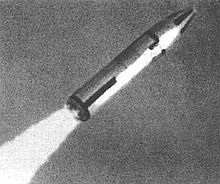Italian nuclear weapons program
The country converted the light cruiser Giuseppe Garibaldi and developed and tested a ballistic missile called Alfa.
[3] The Army was confronted with defending mountain passes, which would channel any Warsaw Pact advance, and therefore made ideal targets for nuclear weapons.
[4] In the new geopolitical situation of the emerging Cold War, Italy created a political strategy that relied on multilateralism, principally through a close relationship with the United States, membership of NATO and greater European integration, for its defence.
MLF was a concept promoted by the United States to place all NATO nuclear weapons not operated by their own services under joint control by American and European forces, with a dual-key arrangement.
[18] Under the MLF, the United States proposed that various NATO countries operate the UGM-27 Polaris IRBM on seaborne platforms, both nuclear submarines and surface ships.
[21] Shortly afterwards, in December 1962, Italian Minister of Defence Giulio Andreotti officially asked the United States for assistance in developing nuclear propulsion for its fleet.
[22] At the Eighteen Nation Committee on Disarmament, the Italian government argued that multilateral activity like the MLF was excluded from any agreement on non-proliferation, but found that the Soviet Union required that MLF be terminated as part of their negotiations on the Non-Proliferation Treaty, and the United States all but killed the agreement on 17 December 1964 with National Security Action Memorandum No.
Officially the project was termed as a development effort for a study on efficient solid-propellant rockets for civil and military applications.
[10] In more recent years, the country, working as part of the European Space Agency, has demonstrated the reentry and landing of a capsule called IXV.
[29] In the 1950s, the Italian population was generally considered ignorant on matters of the high politics of the recently emerged Atomic Age.
While there was a strong awareness of the risk of nuclear war and a desire for disarmament, this was not widely articulated and public discourse was rare.
[31] At the same time, Italian physicists like Edoardo Amaldi spoke out against the use of nuclear research in war, particularly through multinational action like the Pugwash Conferences on Science and World Affairs.
[32] Throughout the 1960s and 1970s, programs and magazine articles on the dangers of nuclear war remained popular and the level of discussion on the issue increased.
[33] The creation of an Italian nuclear deterrent was not widely supported, and when new US weapons were deployed, the government kept them as quiet as possible to avoid unleashing a backlash.
At the same time as the Greenham Common Women's Peace Camp was being set up in Berkshire, England, 60,000 people marched from Perugia to Assisi against nuclear war on 27 September.
[48] The movement received another boost in 1987 when, in the wake of the Chernobyl disaster, a series of referendums demonstrated popular opinion against nuclear power.
In June, senior politicians across the political spectrum, Massimo D'Alema, Arturo Parisi, Gianfranco Fini, Giorgio La Malfa and Francesco Calogero, signed a statement in favour of disarmament.




